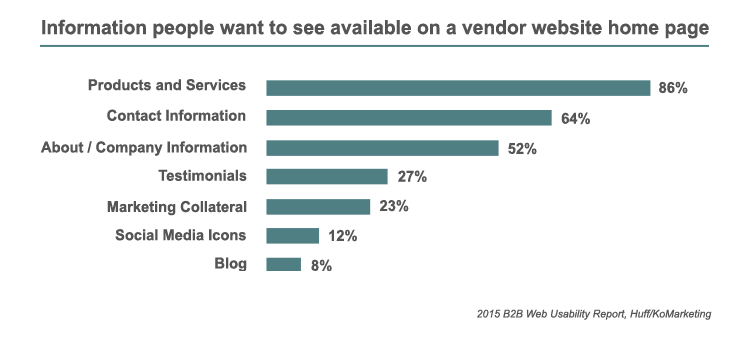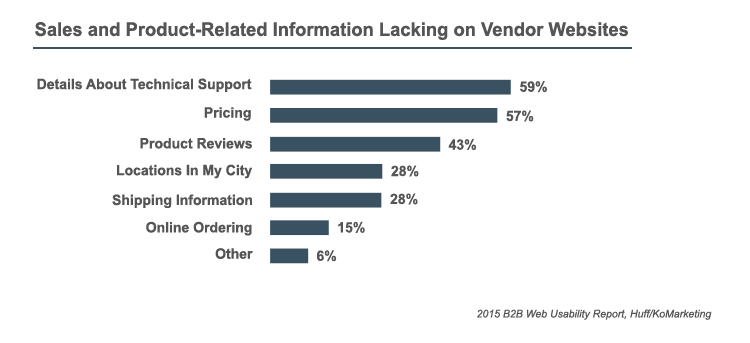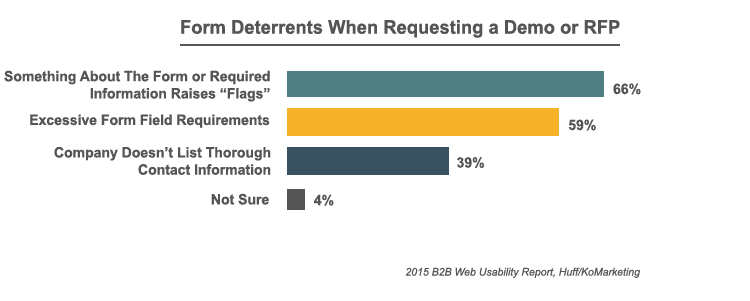 What do B2B buyers actually want from your website? What causes them to leave your website and not return? How many times do typical buyers return to your website before taking the next or final step in the buyer's cycle? What kind of content is important to them?
What do B2B buyers actually want from your website? What causes them to leave your website and not return? How many times do typical buyers return to your website before taking the next or final step in the buyer's cycle? What kind of content is important to them?
We looked at the results of the 2015 B2B Web Usability Survey and discovered what it would take for you as a B2B vendor to create credibility and trust. Spoiler alert: it’s not rocket science.
1) Buyers won’t give you a chance until they’ve seen legitimate identification
Vendors beware: Buyers judge your company’s credibility from their first impressions of your website. Before you panic, a winning introduction simply requires making the ABC’s available, right away. This includes: Complete contact information, an updated About section or company information, and a summary of the products and services your business offers. Interesting to note: They usually don't want to see the pricing first.

Improve your credibility
- Design your website page templates with a built-in header and footer to feature your company’s physical address, contact information, quick links to your products and services page, and a summary of your About section.
- Stock images ring alarm bells for B2B buyers! Even if you and your employees can't measure up to those stock photography models in the looks department, you'll definitely trump them when it comes to trust and credibility. Hire a professional photographer for a day, but don’t stop at head shots for your about page. Employing banner images that picture your employees going about their daily tasks go a long way towards proving your company’s legitimacy. Also, this simple visual introduction can smooth over the awkwardness of that first personal consultation.
2) Buyers want to see the basics before getting in touch
Making a good first impression, however, is not enough motivation for your buyers to introduce themselves. While video tutorials, visual depictions, and audio descriptions are valuable tools for strengthening the relationship with buyers of different learning styles, respondents indicated that these wouldn’t dazzle them into submitting a contact request either.
In reality, for buyers who are leaning towards contacting you for a quote, the deciding factor is whether or not you have supplied them with the following basic content essentials: Product pricing, product reviews, lead/ship times, and details about technical support.

Improve your credibility
- Prioritise your content calendar! While not every buyer that visits your website will be ready to speak to a Sales representative right away, some inevitably will be. Make sure that you don’t miss out on these low-hanging fruit by fast-tracking content assets that buyers require before taking the step of reaching out to your sales team.
- Is your failure to display pricing information on your website losing you sales opportunities? A simple experiment can settle the issue: Add pricing information to your website for a trial period to compare the number of leads generated in both scenarios.
- Are you a software reseller or IT services company? Don’t make the mistake of assuming that your prospects and customers are as technically fluent and self-sufficient as you are! Data shows that providing your customers with direct access to technical support from your website will help you to build credibility and trust with prospects as well.
3) Blogging and Social Media alone won’t win you more than casual followers
B2B buyers have spoken, and the word is that they are seriously underwhelmed by vendors who don’t offer them educational content beyond the weekly blog and social posts.
While both of these marketing channels are valuable for generating traffic and nurturing leads along their buyer’s journey, an effective content marketing strategy relies on a much wider range of assets.

Improve your Credibility
How are you supposed to know which content assets you need to establish yourself as a reputable vendor? Look no further than Science!
Here’s how you can apply the scientific method to your content creation process: Research, Test, Improve, Test, Repeat.
- Research your users’ content preferences. You can do this by interviewing your existing customers, sending them a survey, and evaluating your website’s user analytics to identify high and poor performing content assets.
- Test your assumptions! Create a content asset according to your research findings, put it out there and measure the results. How did you do?
- Improve. Are you getting closer or further away from your goal of engaging and educating your buyers? Unsure? Conduct an A/B test! Focus on one element at a time, (e.g. content format, title, marketing channel) and create multiple versions of the same offer to test the impact of the variable.
How do your buyers feel about your website's credibility? Book a free website assessment now to find out.
4) Buyers don’t trust websites filled with distractions
When it comes to establishing trust and credibility, clarity trumps the bells and whistles. B2B buyers have little patience for features that waste their time and obstruct them from getting down to business.
Website elements that annoy your users enough to make them leave right away include lack of contact information, intrusive live chat features, animated ads, popups, poor design or navigation, and video or audio that plays automatically. Almost half of respondents declared that they would ditch a vendor’s website simply because it fails to clearly communicate what the company does!

Improve your Credibility
Let’s talk about Growth-driven Design (GDD)! As opposed to traditional web design that is driven by your agency or company’s fancies, the GDD process is user-focussed from start to end.
The GDD design cycle entails user research (identifying the drivers, barriers, and hooks at work on your website), implementation of research, and measurement of results to deliver continuous improvement of user experience and conversion rates.
5) Buyers will fill out a form if it passes the cost vs. value test.

Your buyers’ personal contact information is a valuable commodity, and if you want it, you will have to earn it. Excessive form fields, invasive questions, and automatic email subscription are all factors that make your buyers flee from your forms.
Improve your credibility
Fear not, getting on first name basis with buyers is not an impossible feat, as they are more than willing to complete your forms when they meet the following criteria:
- Your forms pass the credibility test. Buyers indicate that the slightest oddity in design or copy could deter them from completing a form. Make sure your forms are sleek and professional by following conversion optimisation best practices on your landing pages, then user testing to identify any red flags.
- Clear and accurate expectations. Are you offering your prospect a free demo or a quote? Buyers’ past experiences of waiting in vain for a response has made them hesitant to submit your contact forms. Here too, clarity trumps persuasion; write your landing page copy to clearly state what buyers can expect once they’ve clicked that submit button. Should they expect to be contacted by a member of your technical support team, sales, or the business owner themselves? When can they expect to hear from you?
- A worthy trade. If you are form-gating your content, the asset on offer better be a value-add for your buyers! While an in-depth eBook would pass this test, spec sheets and product descriptions that blow your own horn should always be offered un-gated!
6) Buyers leave and return to your website multiple times

A prolonged and well-considered decision-making journey is typical of the B2B buyer cycle. In fact, buyers will visit your website up to 5 times before gathering up the courage to get in touch.
During this period, prospects will be evaluating your competitors’ products and solutions, researching your ratings, and looking into feedback from your previous customers. What they find out about your company will determine if they return to your website at all and if you are trustworthy enough to approach for a quote.
Improve your Credibility
Build out a C & C portfolio (Credibility and Comparison) to distribute to your buyers in a marketing automation workflow that gets triggered the moment a buyer transitions to lifecycle stage: Sales Qualified Lead.
Content assets to distribute in this workflow could include:
- Charts and checklists that help your buyers to compare apples with apples as their weigh you up with competitors.
- Case studies of how you have helped other B2B buyers, just like them, to overcome various obstacles to achieve success.
- Credibility by association. Have any of your customers reviewed your business on an external site? Craft an email that shares links to existing reviews with your buyers, and set up a Google Alert to pick up on any new mentions of your company online.
7) A Mobile-friendly website matters

When it comes to devices, 41% of buyers who own a smartphone or tablet are using it to search for B2B products. While most respondents indicated that lack of a mobile-friendly website would not put them off a vendor, a vast majority stated that they do expect your website to enable dialling your number automatically at a tap.
Improve your Credibility
While the look of a mobile unfriendly website might not put off your buyers, poor mobile functionality will result in conversion opportunities slipping through your fingers as well as a poor ranking in search engine results.
While basic mobile-responsiveness ensures accessibility of digital assets (website, blog, CTA’s, forms, landing pages, content offers, emails), optimisation of your entire conversion path for mobile users is a worthwhile investment.
Generating credibility and trust? Elementary, my dear B2B business owner!
Nobody said B2B marketing wasn't hard work, and yet generating trust and credibility does not require you to produce ads that can compete in the Cannes Lions or video material worthy of a BAFTA.
Get to grips with the basics of inbound marketing, power it up with growth-driven design, and you can expect to see your website cranking up the traffic volumes, conversion rates, and new and recurring business.

from HubSpot Marketing Blog http://blog.hubspot.com/marketing/how-b2b-vendors-can-generate-trust-with-website
Via http://blog.hubspot.com/marketing/how-b2b-vendors-can-generate-trust-with-website
No comments:
Post a Comment